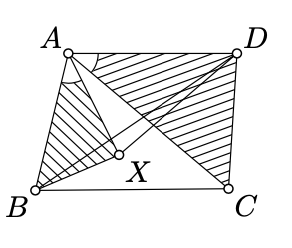6.4: La desigualdad de Tolomeo
- Page ID
- 114368
Un cuadrilátero se define como un cuádruple ordenado de puntos distintos en el plano. Estos 4 puntos se denominan vértices de cuadrilátero. El cuadrilátero ABCD también será denotado por\(\square ABCD\).
Dado un cuadrilátero\(ABCD\), los cuatro segmentos\([AB]\)\([BC]\)\([CD]\),,, y\([DA]\) se llaman lados de\(\square ABCD\); los dos segmentos restantes\([AC]\) y\([BD]\) se llaman diagonales de\(\square ABCD\).
En cualquier cuadrilátero, el producto de las diagonales no puede exceder la suma de los productos de sus lados opuestos; es decir,
\[AC \cdot BD \le AB \cdot CD + BC \cdot DA\]
para cualquier\(\square ABCD\).
Presentaremos una prueba clásica de esta desigualdad utilizando el método de triángulos similares con una construcción adicional. Esta prueba se da como ilustración — no se utilizará más en la secuela.
- Prueba
-

Considera la media línea\([AX)\) tal que\(\measuredangle BAX = \measuredangle CAD\). En este caso\(\measuredangle XAD = \measuredangle BAC\) ya que la adición\(\measuredangle BAX\) o\(\measuredangle CAD\) a los lados correspondientes produce\(\measuredangle BAD\). Podemos suponer que
\(AX = \dfrac{AB}{AC} \cdot AD.\)
En este caso tenemos
\(\dfrac{AX}{AD} = \dfrac{AB}{AC}\),\(\dfrac{AX}{AB} = \dfrac{AD}{AC}.\)
De ahí
\(\triangle BAX \sim \triangle CAD\),\(\triangle XAD \sim \triangle BAC\).
Por lo tanto,
\(\dfrac{BX}{CD} = \dfrac{AB}{AC}\),\(\dfrac{XD}{BC} = \dfrac{AD}{AC}.\)
o, equivalentemente
\(AC \cdot BX = AB \cdot CD\),\(AC \cdot XD = BC \cdot AD\).
Sumando estas dos igualdades obtenemos
\(AC \cdot (BX + XD) = AB \cdot CD + BC \cdot AD\).
Queda por aplicar el triángulo de desigualdad,\(BD \le BX + XD\).
Utilizando la prueba anterior junto con el Corolario 9.3.2, se puede demostrar que la igualdad se mantiene sólo si los vértices\(A, B, C\), y\(D\) aparecen en una línea o un círculo en el mismo orden cíclico; véase también Teorema 10.4.1 para otra prueba del caso de igualdad. El ejercicio 18.3.2 a continuación sugiere otra prueba de la desigualdad de Tolomeo usando coordenadas complejas.


